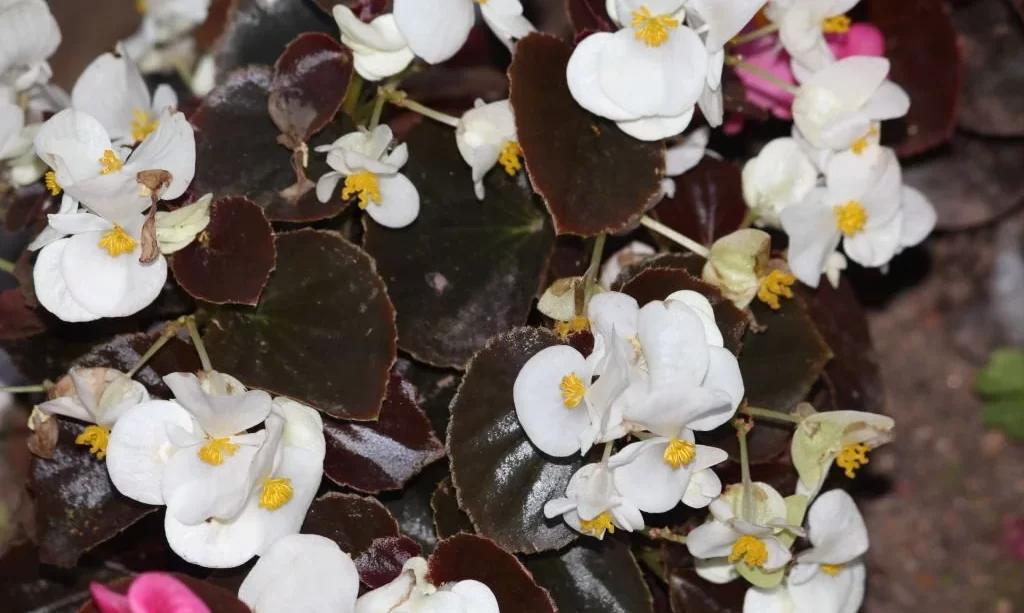Begonias, with their striking beauty and versatility, have long been cherished additions to gardens, window boxes, and indoor plant collections. These delightful flowering plants, known for their vivid and long-lasting blooms, bring a touch of elegance to any setting. But, as begonia enthusiasts tend to their verdant companions, a common question arises: Do you deadhead begonias? To answer this question, we embark on a journey into the world of begonia care, where understanding the diverse range of begonia varieties is the first step in unraveling the mysteries of their maintenance.
- New Liquid Fertilizer for: Begonia Species indoor and outdoor
- This food for plants belongs to the latest generation of fertilizers, for healthy and bright green leaves, stable branches, strong bud formation, balanced rooting, very beautiful flowers.
- Very rapid effects, can be administered via the roots and as a foliar fertilizer. For 60-125 liters of ready to use liquid fertilizer
- Content: 250 ml, works as an economical concentrate. Simple dosage with the help of the cap.
- The fertilizers from the GREEN24 PROFI LINE were developed by gardeners of various departments and were evolved and produced based on the current knowledge in the field of propagation and cultivation of plants.
Begonia Varieties
Begonias are a diverse and captivating group of plants, encompassing various species and hybrids. Each type of begonia exhibits unique characteristics, growth habits, and, importantly, flowering patterns. Here, we delve into the fascinating array of begonia varieties:
- Tuberous Begonias: These begonias are celebrated for their stunning, often pendulous flowers that resemble delicate roses or camellias. Tuberous begonias thrive in a range of vibrant colors and are well-suited for hanging baskets, containers, and garden beds.
- Fibrous-Rooted Begonias: Fibrous-rooted begonias, also known as wax begonias, are cherished for their clusters of waxy, often pink, red, or white blossoms. These begonias are known for their robust growth and are commonly used as bedding plants or border accents.
- Rex Begonias: Unlike their flowering counterparts, rex begonias are prized for their captivating foliage. These begonias display intricate patterns and vibrant colors on their leaves, making them prized collectibles among plant enthusiasts.
- Tropical Begonias: This category encompasses various begonias adapted to tropical environments. They may include rhizomatous begonias with unique leaf shapes and textures, as well as cane begonias with tall, bamboo-like stems adorned with colorful leaves.
- Semperflorens Begonias: Commonly known as bedding begonias or annual begonias, semperflorens begonias are valued for their constant and profuse flowering. They are typically used as seasonal garden additions or potted plants.
Understanding the distinctions among these begonia varieties is essential, as it forms the foundation for tailoring your care routine to each specific type. While the question of whether to deadhead begonias hinges on the variety you have, it is equally vital to grasp the unique growth patterns and requirements that characterize each begonia species and cultivar. In the following sections, we will explore the nuances of begonia care and provide guidance on whether deadheading is a necessary practice for your begonia companions.
The Purpose of Deadheading
Before delving into the specifics of deadheading begonias, it’s essential to understand the purpose and benefits of this gardening practice. Deadheading is the art of removing spent or faded flowers from a plant. Here’s why it matters:
- Encouraging Continuous Blooming: The primary goal of deadheading is to stimulate the production of new flowers. When you remove faded blooms, the plant redirects its energy away from seed production and toward creating fresh blossoms. This results in more prolonged and abundant flowering throughout the growing season.
- Enhancing Aesthetic Appeal: Deadheading not only promotes more blooms but also improves the overall appearance of the plant. By removing unsightly wilted flowers, your begonias maintain a neater and more attractive appearance, enhancing the visual appeal of your garden or indoor display.
- Preventing Seed Formation: Allowing begonia flowers to go to seed can deplete the plant’s energy and reduce its flowering vigor. Deadheading prevents seed formation, ensuring that the plant channels its resources into healthy growth and flowering instead.
Do You Deadhead Begonias?
The question of whether to deadhead begonias is met with a nuanced answer—it depends on the specific type of begonia you have:
- Deadheading Fibrous-Rooted Begonias: Fibrous-rooted begonias, also known as wax begonias, greatly benefit from deadheading. These begonias produce clusters of flowers throughout the growing season, and regular deadheading helps maintain their profuse and continuous bloom.
- Tuberous Begonias: Tuberous begonias, on the other hand, may not require deadheading to the same extent. These begonias naturally shed their spent flowers, and the process of removing faded blooms from tuberous begonias can be less critical. Instead, focus on other aspects of their care, such as adequate watering and light conditions.
In the following section, we’ll explore how to deadhead fibrous-rooted begonias effectively to ensure a vibrant and flourishing display of blossoms.
Deadheading Fibrous-Rooted Begonias
Deadheading fibrous-rooted begonias is a straightforward process that can greatly enhance the plant’s appearance and blooming performance:
- Tools Needed: To deadhead, you’ll need a pair of clean and sharp pruning shears or scissors. Ensure that your tools are sanitized to prevent the spread of diseases between plants.
- Identification: Examine your fibrous-rooted begonia plant for faded or spent flowers. These are typically easy to spot, as they wilt and lose their vibrant color.
- Trimming Technique: Locate the stem just above a healthy leaf or leaf node. Using your pruning shears or scissors, make a clean cut at a slight angle, removing the spent flower and a small portion of the stem. This encourages new growth from the leaf node.
- Regular Maintenance: Deadhead your fibrous-rooted begonias regularly throughout the growing season, ideally as soon as you notice faded blooms. This proactive approach ensures a continuous cycle of blossoms.
By practicing effective deadheading on your fibrous-rooted begonias, you’ll enjoy an impressive and enduring display of their charming flowers. Remember that while deadheading is particularly beneficial for this begonia type, it’s not a one-size-fits-all approach, and other begonia varieties may have different care requirements.
- Make Pruning Work Easier: Rust-resistant stainless steel blade are sharp and durable for easy and smooth cut.Anti-slip and ergonomic handle make the gardener clippers more comfortable in your hand.Easy-open spring action reduces hand fatigue while cutting. you can easily to cut without damaging the vital stems and branches of your plants
- User-friendly Safety Lock: These garden shears have locking mechanisms to keep the sharp blades securely closed when not in use.It is easy to maneuver and can effectively reduce accidental injuries. And the closing mechanism is firmly enough, you don’t need to worry the plant pruning shears will get locked accidentally during use
- Garden Gloves for Hand Protection: One size fits most. This Gardening gloves,made of soft & comfortable cotton fabric,can protect yourself from dirt, skin wounds and nasty splinters when doing yard chores. The grip latex coating provides anti-slip or sure control when grabbing garden & yard tools
- Widely Used: This gardening shears set comes with 3 different blades for a variety of general pruning tasks.It is ideal for harvesting or trimming herbs,flowers,house plants, hydroponics,bonsai,cutting stems or light branches,or other cutting needs in the garden. It would also be a perfect gift for a gardening friend
- Customer support: Please feel free to tell us if you have any questions about our garden shears pruning. Note:Keeping your pruner shears cleaned and well-oiled can extend their lifespan. Please dry and clean it after use. Note: The colors of the garden pruners and gloves will be shipped at random
Care for Tuberous Begonias
Tuberous begonias, with their stunning rose-like blooms, require a specific care regimen that differs from their fibrous-rooted counterparts:
- Light: Tuberous begonias thrive in bright, indirect light. Protect them from harsh afternoon sun, as it can scorch their delicate leaves.
- Watering: Keep the soil consistently moist but not waterlogged. Water when the top inch of soil feels dry. Avoid splashing water on the foliage, as tuberous begonias are susceptible to mildew.
- Fertilization: Fertilize tuberous begonias with a balanced, water-soluble fertilizer every two to four weeks during the growing season. Reduce fertilization in the winter when the plant is dormant.
- Overwintering: Tuberous begonias go dormant in the winter. Reduce watering gradually as the leaves die back, and store the tubers in a cool, dry place until spring. Replant them when the danger of frost has passed.
- Deadheading: While deadheading tuberous begonias isn’t as critical as with fibrous-rooted varieties, you can remove faded flowers if desired. This may encourage a tidier appearance.
General Begonia Care Tips
For begonias of all varieties, including fibrous-rooted, tuberous, and other types, consider these general care tips:
- Soil: Use well-draining, high-quality potting mix. Begonias prefer slightly acidic soil with good aeration.
- Containers: If growing begonias in pots, ensure that the containers have drainage holes to prevent waterlogged roots.
- Humidity: Begonias appreciate higher humidity levels. You can increase humidity around the plants by misting them or using a humidity tray.
- Pest Control: Monitor your begonias for pests like aphids or mealybugs. If infestations occur, address them promptly with natural or chemical treatments.
- Winter Care: Depending on your region’s climate, consider bringing outdoor begonias inside during the colder months to protect them from frost.
- Pruning: Regularly prune leggy or overgrown stems to maintain a compact and bushy appearance.
- 🌸 Begonia Brilliance: Elevate your Begonia plant care with Gardenera’s meticulously crafted Begonia Potting Mix, tailored for optimal growth and vitality.
- 🌿 Premium Ingredients for Flourishing: Our potting mix is an exquisite blend of Canadian Peat Moss, nutrient-rich Worm Castings, Charcoal, Sand, and Vermiculite. This carefully balanced combination provides your Begonia plants with the essential elements for thriving.
- 💧 Hydration Harmony: Canadian Peat Moss and Vermiculite collaborate to maintain consistent moisture levels, offering an environment that keeps your Begonia’s roots well-hydrated and vibrant.
- 🌱 Organic Nutrient Infusion: The inclusion of Worm Castings enriches the mix with organic nutrients, promoting robust foliage growth, blossoming flowers, and overall plant health.
- 🪴 Balanced Drainage and Aeration: Charcoal and Sand enhance the mix’s structure, facilitating optimal drainage and root aeration. This dynamic duo ensures that water moves efficiently through the soil while providing roots with the necessary oxygen.
Conclusion
In the enchanting world of begonias, the question of whether to deadhead reveals itself as a consideration steeped in the nuances of begonia variety. While fibrous-rooted begonias thrive with regular deadheading to promote continuous flowering, tuberous begonias have different care requirements, where deadheading may be less crucial to their growth.
Ultimately, successful begonia care involves understanding the unique needs of your begonia type and tailoring your gardening practices accordingly. Whether you’re tending to the vibrant clusters of fibrous-rooted begonia blossoms or admiring the intricate foliage of rex begonias, the key lies in fostering an environment that supports their health and vitality.
As you navigate the realm of begonias, remember that these resilient plants are equally adaptable to outdoor gardens, indoor spaces, or hanging baskets, offering beauty and charm wherever they flourish. By embracing the art of begonia care, you can cultivate a delightful haven of begonia blooms, enhancing the natural grace and allure of your living spaces.






